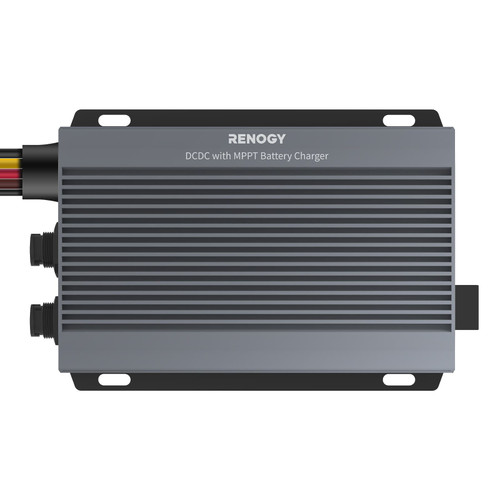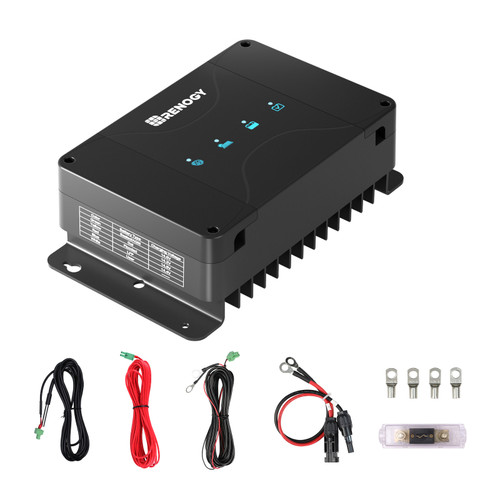-
Do I need a solar battery charger?
Batteries will drain when they sit idle for too long. This is a common issue for RV owners who keep their RV’s parked in the driveway over the winter and forget to keep their batteries charged. Batteries will experience permanent damage if they are discharged for a long period of time. This can be avoided with using solar battery chargers.
Battery chargers collect enough energy to charge and safely maintain the house batteries in your RV, van, or wherever your battery bank is being stored. They can also be used as a back-up charging source for your system when you find yourself depleting your battery bank without access to sunlight, such as during bad weather.
Depending on the voltage of your batteries, you have to choose between 12V battery chargers and 24V battery chargers. Also, battery chargers are divided into AGM battery chargers, deep cycle battery chargers, lithium battery chargers, universal chargers, and so on. You may pay attention to the compatibility of the battery charger and your battery before charging, or consult technical personnel to avoid possible damage to your battery.
-
Can I charge my solar batteries with an outlet?
If you have lithium iron phosphate batteries, you can use the Renogy 20A AC-to-DC Charger to charge your battery with a wall outlet. The charger kit includes 12AWG alligator clips and outputs power based on the battery's power, voltage, and current condition. The unit's status indicator light lets you know the connected battery's operating mode and condition. Once the battery hits full charge, the Portable LFP charger automatically monitors and maintains the battery.
-
Can I charge my solar batteries with my alternator?
Yes, we recommend using Renogy's DC to DC MPPT Charger to charge a secondary battery from an alternator connected to a primary battery or by utilizing solar panels connected directly to the unit. While your vehicle's alternator prioritizes your primary battery, the DC to DC MPPT charger gives your solar system to put your secondary battery first. Renogy's DC to DC MPPT Charger will also work with flooded lead acid, gel, AGM, or lithium iron phosphate batteries.
-
How do I charge both my house batteries and my solar battery?
We recommend purchasing Renogy 12V DC to DC On-Board Battery Charger. This charger is designed to charge secondary batteries while driving, using the primary battery connected to the alternator. While your vehicle's alternator prioritizes your starting battery, this allows your solar system to charge your service battery first. It's the smart way to keep yourself fully charged and off-grid longer. This charger can be used with flooded lead acid, gel, AGM, or lithium iron phosphate batteries.
-
What is a trickle charger maintainer?
Before storing a battery for an extended time, it’s best to ensure it is fully charged. Also, ensure charging battery periodically during storage so that when you need the battery for your application, it is ready. Using trickle chargers removes the need to recharge periodically by providing a continual low charge to the battery without the apparent risk of overcharging. Trickle charging refers to charging a fully charged battery at a rate equal to its self-discharge rate, thus allowing the battery to remain fully charged. Note that the state occurs only when the battery is not loaded, as a trickle battery charger cannot keep a battery charged if a load is drawing current.
Renogy’s 5, 8, and 10 watt solar battery trickle charger maintainer will help you maintain a healthy battery by converting solar energy into a usable 12V DC current to keep your battery topped off at a stable level. With quick SAE connection and 3 options for ring terminals, alligator clips, and cigarette lighters, our battery maintainers are sure to be a great fit no matter what your application needs. It works great with boats, SUVs, RVs, electric fences, accessory batteries, and much more! Maintain a healthy battery and never be caught flat ever again!
-
What size solar panel to charge 12 volt battery?
If you have a 200ah battery, only 80% of that is usable due to depletion limitations, so you really only have 160 amp-hours of energy to draw on. If you learn that you typically can last two days with energy from that battery, that means you consume 80 amp hours a day. A 100 watt solar panel will produce an average of about 30 amp-hours per day (based on an average sunny day). This means you would need three 100 watt solar panels or one 300 watt solar panel to fully recharge your battery on the average day.
Your solar panels will first need to be connected to a battery charger which will help prevent overcharging. Battery chargers will also shut down a system if the batteries become too depleted. Before powering your appliances, your batteries will need to be connected to an inverter to convert the DC energy collected from solar panels and converted to AC energy.






















